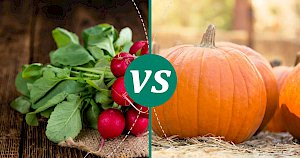Pumpkin vs Radish: Nutrition, Calories & Protein Compared


Pumpkin vs Radish
Nutrition Facts
Serving size:
change
5g10g15g20g30g40g50g60g80g100g120g140g160g180g200g220g250g300g350g400g450g500g600g700g800g900g1000g
1oz2oz3oz4oz5oz6oz7oz8oz10oz12oz15oz20oz25oz30oz35oz40oz50oz
Amount Per Serving:
Serving size:
change
5g10g15g20g30g40g50g60g80g100g120g140g160g180g200g220g250g300g350g400g450g500g600g700g800g900g1000g
1oz2oz3oz4oz5oz6oz7oz8oz10oz12oz15oz20oz25oz30oz35oz40oz50oz
Amount Per Serving:
Pumpkin vs Radish 100g Compare
| per 100g | Pumpkin | Radish |
|---|---|---|
| Calories | 26 | 16 |
| Carbohydrates | 6.5 g | 3.4 g |
| Fat | 0.1 g | 0.1 g |
| Dietary fiber | 0.5 g | 1.6 g |
| Protein | 1 g | 0.68 g |
| Calcium | 21 mg | 25 mg |
| Iron | 0.8 mg | 0.34 mg |
| Magnessium | 12 mg | 10 mg |
| Potassium | 340 mg | 233 mg |
| Sodium | 1 mg | 39 mg |
| Zink | 0.32 mg | 0.28 mg |
| Vitaminium A | 7384 µg | 7 µg |
| Vitaminium B2 (riboflavin) | 0.11 mg | 0.039 mg |
| Vitaminium B3 (Niacin) | 0.6 mg | 0.254 mg |
| Vitaminium B6 | 0.061 mg | 0.071 mg |
| Vitaminium B9 (Folic acid) | 16 mg | 25 mg |
| Vitaminium C | 9 mg | 14.8 mg |
| Vitaminium K | 1.1 µg | 1.3 µg |
Discovering the Nutritional Gems: Pumpkin and Radish
When it comes to adding variety and nutrition to our diets, both pumpkin and radish stand out for their unique flavors and health benefits. While pumpkin is celebrated for its rich, sweet flavor that symbolizes fall, radishes offer a crisp, spicy kick that can enhance any salad. But beyond their taste, how do these two vegetables compare in terms of nutrition?
A Closer Look at Pumpkins
Pumpkins are not just for carving jack-o'-lanterns; they are a powerhouse of nutrients. With only 26 calories per 100 grams, pumpkins are low in calories yet high in vitamins and minerals. They boast an impressive 7384 IU of Vitamin A, making them an excellent choice for eye health. Pumpkins are also a good source of fiber, with 0.5 grams per serving, which can aid in digestion and help you feel full longer.
Radishes: Crunchy and Nutritious
Radishes, with their peppery flavor and satisfying crunch, are often overlooked in the nutrition department. However, at just 16 calories per 100 grams, they are an incredibly low-calorie option for those looking to manage their weight. Radishes are rich in Vitamin C, providing 14.8 mg per serving, which is essential for immune health. They also offer a good amount of fiber, with 1.6 grams, surpassing pumpkins in this category.
Comparing Nutritional Values
When comparing pumpkin and radish, it's clear that both vegetables offer distinct nutritional profiles. Pumpkins have a higher content of beta-carotene, which is converted into Vitamin A in the body, while radishes contain more Vitamin C and slightly more calcium. Both are equally low in fat, with only 0.1 grams per serving, and contain no cholesterol, making them heart-healthy choices.
In terms of macronutrients, pumpkins have more carbohydrates, with 6.5 grams compared to radishes' 3.4 grams, and slightly more protein. However, radishes take the lead in dietary fiber, which is crucial for maintaining a healthy digestive system.
Which One to Choose?
Ultimately, the choice between pumpkin and radish comes down to personal preference and dietary needs. If you're looking for a vegetable high in Vitamin A and carbohydrates for energy, pumpkin is a great choice. On the other hand, if you prefer a low-calorie option that packs a punch in terms of Vitamin C and fiber, radishes are your go-to.
Both pumpkin and radish can be incorporated into a variety of dishes, from soups and salads to curries and side dishes. Experimenting with these vegetables can not only add a burst of flavor to your meals but also provide a host of nutritional benefits.
Whether you lean towards the sweet richness of pumpkin or the crisp bite of radish, incorporating these vegetables into your diet is a step towards a balanced, healthful eating plan. So, why not enjoy the best of both worlds?
Pumpkin 100g
26kcalCalories source
- 84% CARBS.
- 13% PROTEIN
- 3% FAT
Radish 100g
16kcalCalories source
- 79% CARBS
- 16% PROTEIN
- 5% FAT
Compares of pumpkin
- Pumpkin vs Asparagus
- Pumpkin vs Bamboo Shoots
- Pumpkin vs Beetroot
- Pumpkin vs Pepper
- Pumpkin vs Bitter Melon
- Pumpkin vs Calabash
- see all compares of pumpkin
Marcin Piotrowicz
calories-info.com creator
Healthy diet and healthy lifestyle promoter
Add comment